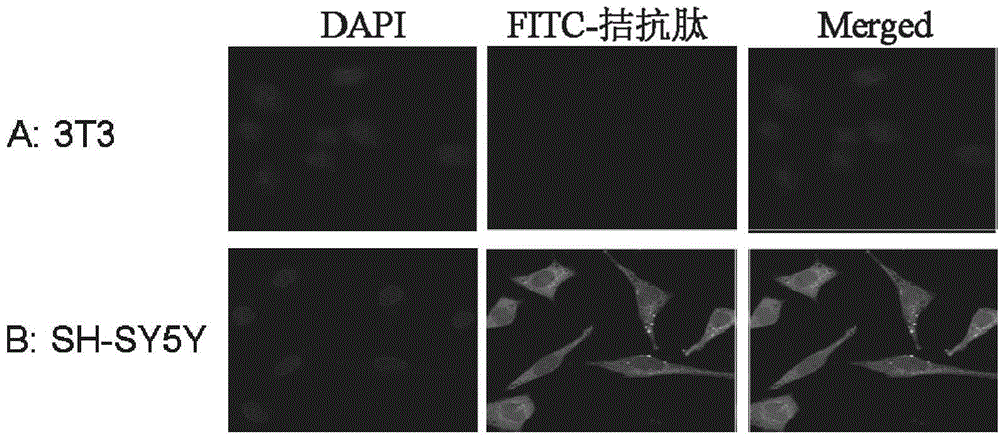Specific antagonist peptide for advanced glycation end product receptor as well as derivatives and application of specific antagonist peptide
A technology of advanced glycation and final product, applied in the field of biomedicine, can solve problems such as exceeding endocytosis capacity, damaging nerve cells, affecting mitochondrial function, etc.
- Summary
- Abstract
- Description
- Claims
- Application Information
AI Technical Summary
Problems solved by technology
Method used
Image
Examples
Embodiment 1
[0033] Example 1 Organic Synthesis of Specific Antagonist Peptide for Advanced Glycation End-Product Receptor
[0034] Adopt CS936 peptide synthesizer (USA CSBio company), Fmoc solid-phase synthesis method synthesis (synthesized by Shanghai Qiangyao biological company), the synthesis process includes the following steps:
[0035] (a) Deprotection: use piperidine (piperidine, Shanghai Ziyi Reagent Factory) solution to remove the protecting group of the amino group;
[0036] (b) Activation and cross-linking: the carboxyl group of the next amino acid is activated and dissolved by the activator HBTU (HCTU / HITU)+NMM, and the activated monomer reacts with the free amino group to form a peptide bond;
[0037] (c) cycle: (a), (b) two-step reaction cycle repeatedly until the entire peptide chain is synthesized;
[0038] (d) Elution and deprotection: According to the different residues contained in the peptide chain, it is eluted from the column with different deresin solvents, and its...
Embodiment 2
[0042] Example 2 The specific antagonistic peptide of the advanced glycation end product receptor binds specifically to RAGE on the cell membrane surface of cells with high expression of RAGE
[0043] The advanced glycation end product receptor-specific antagonist peptide prepared in Example 1 was labeled with FITC (Shanghai Qiangyao Biological Co., Ltd.). Confocal plates were seeded with SH-SY5Y-app cells (ATTC, Manassas, VA, USA), 10,000 cells per dish, and cultured in a carbon dioxide incubator for 24 hours (5% CO 2 , 37°C), then washed three times with PBS, fixed with paraformaldehyde for 15 min, washed three times with PBS, blocked with BSA for 1.5 h, and then used FITC-labeled advanced glycation end product receptor specificity at a final concentration of 100 μmol / mL The antagonistic peptide was incubated at room temperature for 2 hours, washed three times with PBST, stained with DAPI, and observed under a laser confocal scanning microscope (Zeiss, Germany). 3T3 cells (S...
Embodiment 3
[0045] Example 3 Advanced Glycation End-Product Receptor Specific Antagonist Peptide Improves the Survival Rate of AD Model Cells
[0046] (1) 3T3 cells were plated in a 96-well plate, with 10,000 cells per well, and cultured for 24 hours (5% CO 2 , 37°C), remove the original medium, add 100 μL of different final concentrations (0, 0.1, 1, 10, 100 μM) of the specific antagonistic peptide of the advanced glycation end product receptor (prepared in Example 1) to each well, After culturing for 48 hours, the cell viability was measured by MTT method, the results are shown in image 3 a.
[0047] (2) Construction of AD model by Aβ: SH-SY5Y-app cells were spread in 96-well plates, 10,000 cells per well, cultured for 24h (5% CO 2 , 37°C), remove the original medium, add 100 μL of Aβ with different final concentrations (0, 25, 50, 100, 200, 400, 800, 1600 μM) to each well (Aβ is diluted with serum-free medium), culture for 48 hours, MTT The cell viability was measured by the method...
PUM
 Login to View More
Login to View More Abstract
Description
Claims
Application Information
 Login to View More
Login to View More - R&D
- Intellectual Property
- Life Sciences
- Materials
- Tech Scout
- Unparalleled Data Quality
- Higher Quality Content
- 60% Fewer Hallucinations
Browse by: Latest US Patents, China's latest patents, Technical Efficacy Thesaurus, Application Domain, Technology Topic, Popular Technical Reports.
© 2025 PatSnap. All rights reserved.Legal|Privacy policy|Modern Slavery Act Transparency Statement|Sitemap|About US| Contact US: help@patsnap.com



